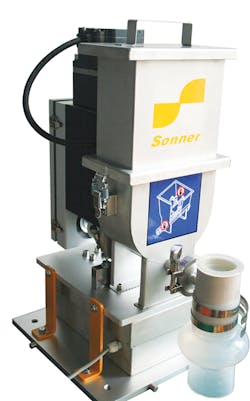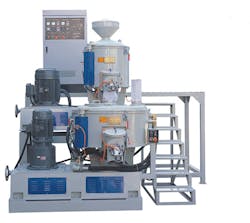Auxiliary suppliers increase efforts to get products into North America
Auxiliary equipment suppliers — among them companies that make and sell blenders, dryers, feeders, dosing devices, pulverizers, etc. — had their wares on display during Chinaplas, held May 20-23 in Guangzhou, and many spoke of the increased effort to get their products into the North American market.
Shanghai Sonner Machinery Co. Ltd., originally based in Shanghai, is a multinational company with a presence in India, the United States and more recently, Düsseldorf, Germany, where it is doing business as Sonner Technologie. In the U.S. market, the company does business as Sonner Technology Co. LLC, based in Akron, Ohio, and as of this writing, it was selecting a site to accommodate its warehouse and laboratory needs. It got its start in the Akron Global Business Accelerator.
"It will be a process to enter this market and we understand that," says sales engineer Michael Madsen, who is overseeing Sonner's business in the U.S. "There is a lot of strong competition that is well-established here." The company is establishing relationships with customers and working to understand the issues they're facing.
"Maybe our machines are the right solution and maybe they're not," says Madsen. "I would never steer them in the wrong direction just to sell a machine."
The company showcased several new products during Chinaplas, including its GBL-ST11/SS23 loss-in-weight microfeeder. This microfeeder is for granulation, laboratory testing and small-scale processes. It can handle easy-flowing and non-easy-flowing materials. The feeder is designed in a modular makeup just like all of Sonner's feeders and it is easy to switch between a single or twin screw.
"There are three steps, and you put in a new screw to take it from single to twin screw," says Madsen.
The ST11's capacity ranges from as low as about 2 ounces up to 7 ounces per hour, while the SS23 goes from about 10.5 ounces to 589 ounces per hour. The accuracy of the whole system reaches plus or minus 0.5 percent. Because the hopper is supplied with a fast-clip connector, it can be removed easily. The idle time is reduced because only a few minutes are needed to clean off the material.
"The goal is to focus on lab testing," Madsen says. "For us, that has the most potential because of the accuracy, the price and the different projects that companies may be working on."
Sonner's FC automatic conveying system is new in that now it can convey powder. The previous iteration conveyed only granules. The system includes Sonner's blower, one or more of its vacuum receivers, a filter and Sonner's M100 controller. This is a new design with a more compact frame and structure that make it more stable to manage vibrations and to send powder efficiently through the system to reduce buildup. The overall machine design requires less raw material, resulting in reduced costs, says Madsen, who described the system as stronger, more efficient and quieter. The filter can now be disassembled and cleaned much more easily. Inside, there is an internally mounted magnetic switch that controls the suction that improves the machine's ability to convey powder.
Immediately following Chinaplas, Sonner introduced its M250 industrial computer, its closed-loop control device for all of its loss-in-weight feeders. This is an upgrade of Sonner's existing system. For example, the screen, now 10.4 inches wide, is larger. Where the last model could control only six to eight feeders, the new model can control up to 20 at once. It can also store as many as 50 recipes.
Several considerations, including usability and design aesthetics, motivated Sonner to make the upgrades.
"There is the ability for anyone working to learn this system easily and be comfortable working with it. We're also seeing a lot of new technology in the industry and keeping up with that is important. This has a data exchange with production-line control system. It can connect to the factory's data-management system with remote access for troubleshooting," says Madsen.
One other change is small but important for the U.S. and Central and South American markets, he says. That is the language feature. The device now has five languages – English, Simplified Chinese, German, Russian and Spanish.
Beyond the equipment introductions, Sonner also has a new website with a clean and simple design in an effort to mimic its machines, Madsen says.
"There was a thought process that went into the design of the website to capture the design aesthetics that our machines incorporate," he says. "It is very easy to navigate, very mobile friendly. That was the goal."
Future improvements will include the addition of case studies and a video series.
Wei Li Plastics Machinery Ltd., Hong Kong, has been honing its PF-Series pulverizing system. This system was developed in 2010, says company representative Yako Tsui, and it has been shown at Chinaplas for each of the last three years. The series has been improved continually since its introduction, including bearings now sourced from SKF of Sweden. Via one-axis disc alignment, the grinding discs are balanced by the bearings to provide stable grinding with an optimal throughput rate.
Tsui says that the company is focusing on several features, including lower energy consumption and ease of operation. For example, the grinding gap between the discs can be adjusted precisely by a simple hand wheel outside the machine. The system can be equipped with optional components, including a metal separator and vibratory separator.
At Taigang Plastic Machinery, Dongguan, China, officials introduced a high-speed mixer and vertical cooling blender that is suitable for mixing PVC, PE and PP, among other resins.
Company official Joyce Wang says that the machinery is new and is made in Taigang's factory in Dongguan. All machinery is available for export to the U.S.
Moretto SpA, Massanzago, Italy, with newly established offices in Columbus, Ohio, introduced its patented DGM Gravix gravimetric blender at NPE for the U.S. market and also had it at Chinaplas in May. Precision is the goal with this blender, which has absolute precision with a 0.001 percent variance. This is made possible through the use of digital technology and the Vibration Immunity System, which features a free-weighing hopper. The weighing hopper is free from mechanical constraints and from any disturbances generated by the machine.
Moretto offers more than 1,000 models in this product range for production levels as low as 66 pounds per hour to as much as 26,455 pounds per hour. It can dose up to 12 materials.
The Gravix can be installed on a floor on a dedicated frame and is also available on pivoting wheels.
Angie DeRosa, managing editor
Contact:
Moretto USA, 614-530-0440, www.moretto.com
Sonner Technology Co. LLC, 847-691-2427, www.sonnerfeeder.com
Taigang Plastic Machinery 86-769-85911665, http://en.e-taigang.com
Wei Li Plastics Machinery Ltd., 852-26902368, www.weiliplastics.com



